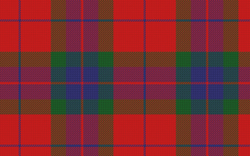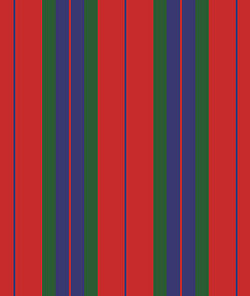![]() A tartan is a plaid sort. The english word tartan is derived from the french word 'tiretain' what refers to woven cloths (as apposed to knitted cloth). Today tartan refers to colored patterns, not limited to textiles. Originally a tartan did not have to be made up of any pattern at all.
A tartan is a plaid sort. The english word tartan is derived from the french word 'tiretain' what refers to woven cloths (as apposed to knitted cloth). Today tartan refers to colored patterns, not limited to textiles. Originally a tartan did not have to be made up of any pattern at all.
The vast majority of historians have assumed that the idea of tartan / plaid was relatively new to scotland in the seventeenth century. Archeology tells a different story, thanks to thorough research by Elizabeth Wayland Barber, there is proof that the Celts have been weaving plaid twills (tartan) for over three thousand years.
All tartans are plaids, not all plaids ar tartan. Basically, with almost every tartan, the pattern on the stripes running vertically is exactly duplicated horizontally. This matching pattern creates a grid. The warp and weft yarns are then woven in a two-over-two 'twill' pattern. Looking at a simple plaid, you will notice that the stripes, either in color, size or pattern, are not the same in both directions.
Tartans first definition is 'woolen cloth woven in stripes of various colors at right angles to form a rectangular pattern'. Plaids original definition is 'woolen cloth having a checkered or tartan pattern'.
All woven fabrics are made up of the warp (threads that are stretched out lengthways on the loom- and the weft (threads that are interwoven with the warp) at right angles to it. The great majority of traditional tartan designs have an identical amount of warp and weft threads.
 For example: in this example we use a traditional 18th century Boblainy pattern. This pattern can be written down in amount of threads per colour. For this example it means:
For example: in this example we use a traditional 18th century Boblainy pattern. This pattern can be written down in amount of threads per colour. For this example it means:
4 blue
56 red
28 green
28 blue
4 red
28 blue
28 green
and so on. If we only look at the warp threads the pattern looks like this:
If we only look at the warp threads the pattern looks like this:
The thread colour pattern flips and mirrors itselfs as soon as we get to 4 red. So, from 4 red we go back to 28 blue, 28 green, 56 red, 4 blue and back again: 56 red, 28 green and so on.
In this example the pivots are 4 blue and 4 red.
Designers and weavers write a pattern down as short as possible: B/4 R56 G28 B28 R/4
The / indicates the pivots, in this case in blue 4 and red 4.
The fact that in a traditional loom the shuttle goes out of the loom and must come back again, has resulted in patterns having even-numbered yarn counts.
Tradidtional design warp --->
____________________________________
Een tartan is een soort geweven ruit. Het woord tartan komt waarschijnlijk uit het frans (tiretain), wat refereert aan geweven stof (in tegenstelling tot een gebreide of genaaide doek). Tegenwoordig verwijst tartan naar kleurrijke patronen, los van de textielsoort. In het begin was er bij tartan niet eens sprake van een patroon.
Tartan / plaid bestaat veel langer dan door historici oorspronkelijk werd aangenomen (17e eeuw in schotland). Dankzij grondig onderzoek door archeologe Elizabeth Wayland Barber is er bewijs dat de Kelten al drieduizend jaar plaid twills weven. Alle tartans zijn plaids, niet alle plaids zijn tartan. Het komt er op neer dat bij de meeste tartans, het streeppatroon op de verticale as exact wordt gedupliceerd op de horizontale as. Dit gelijke patroon maakt een rooster. De ketting- en inslagdraden worden vervolgens geweven in een twee-over-twee 'twill' patroon.
Kijkend naar een eenvoudige plaid, zul je zien dat de strepen, in kleur, grootte of patroon, niet gelijk zijn in beide richtingen (bron: designer Scot Meacham Wood). Tartans eerste definitie is 'wollen doek, geweven strepen van verschillende kleuren in een gelijk rechthoekig patroon'. Plaids oorspronkelijke definitie is 'wollen doek met een ruit of tartan patroon'.
Bij alle geweven stoffen draait het om de draden over de lengte van het weefgetouw (warp) en de draden die haaks daar horizontaal doorheen geweven worden (weft). Het grootste deel van de traditionele tartan ontwerp heeft een identiek aantal horizontale en verticale draden. Bijvoorbeeld: in dit voorbeeld gebruiken we een traditioneel Boblainy patroon uit de 18e eeuw. Het patroon kan uitgeschreven worden in aantal draden per kleur. In dit geval is dat:
Bijvoorbeeld: in dit voorbeeld gebruiken we een traditioneel Boblainy patroon uit de 18e eeuw. Het patroon kan uitgeschreven worden in aantal draden per kleur. In dit geval is dat:
4 blauw
56 rood
28 groen
28 blauw
4 rood
28 blauw
28 groen
enzovoorts Als we kijken naar alleen de verticale lijn ziet dat er als volgt uit:
Als we kijken naar alleen de verticale lijn ziet dat er als volgt uit:
Het kleurpatroon spiegelt zodra je bij 4 rood komt. Dus vanaf 4 rood weer terug naar 28 blauw, 28 groen, 56 rood, 4 blauw en weer terug: 56 rood, 28 groen enzovoorts
In dit voorbeeld zijn de draaipunten/spiegelpunten 4 blauw en 4 rood
Designers en wevers noteren het patroon zo kort mogelijk: B/4 R56 G28 B28 R/4
De / geeft aan waar het draaipunt is, in blauw 4 en rood 4 in dit patroon.
Het feit dat bij een weefgetouw de draad met de shuttle heen en terug moest, resulteerde telkens in een even aantal draden in een patroon.
Traditioneel ontwerp warp --->